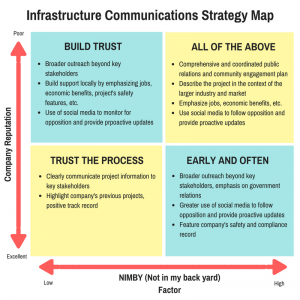Eminent Domain and the Future of Infrastructure

While regulatory issues, such as eminent domain and environmental impact surveys, often determine the ultimate fate of an infrastructure project, having an appropriate communications strategy is essential in moving a project forward in the increasingly important court of public opinion.
In his first address to a joint session of Congress, President Trump stressed the crucial need for maintaining and building infrastructure. Within the energy sector, the Trump administration has specifically encouraged the completion of the Keystone XL and Dakota Access crude oil pipelines by removing federal roadblocks.
In a memo to employees last year, the CEO of the company building the Dakota Access Pipeline said: “Our corporate mindset has long been to keep our head down and do our work.” He went on to say that he preferred to avoid engaging in a media and PR battle. Months later, as the opposition to the pipeline built to a crescendo, he said that they had underestimated the ability of social media to facilitate organized opposition.
Similarly, TransCanada’s Keystone XL Pipeline had been previously stopped in its tracks because of, in large part, organized opposition that pressured the previous administration to withhold required federal approvals. Two major infrastructure projects—both of which appeared to be certain when construction began—were delayed and nearly stopped by opponents who questioned their presumed “license to operate.”
Map Your Communications Strategy
Given these historical challenges, how can companies navigate through opposition and successfully build infrastructure that is otherwise approved and has demonstrated market need? While there is no single answer, the recent examples indicate that an appropriate communications strategy that effectively reaches key influencers can play a large role in determining a project’s timeline and ultimate success.
Pierpont’s Infrastructure Communications Strategy Map can help identify appropriate strategies and tactics by evaluating a project based on the company’s overall reputation and the project’s not-in-my-backyard, or NIMBY, factor.

The company’s reputation, for this purpose, is primarily its online reputation. What will people see when they search for the company behind the proposed project they just heard about? Is there a history of accidents and injuries or fatalities? If pipelines, refineries and processing plants is there a history of spills and releases? Has the company been fined or investigated? The online history may or may not be fair and representative, but it will be seen and used by those opposing the project.
The NIMBY Factor Matters
The NIMBY factor is an assessment of the degree of resistance to a project by those most impacted by its construction. This resistance can be spread among many landowners along a proposed pipeline route hundreds of miles long or concentrated primarily among those within the line of site of a new crude oil storage tank. It is crucial to note that the NIMBY factor can change quickly as information and speculation about the project spreads and opposition begins to build. Those who had not initially opposed the project are often influenced by negative perspectives in traditional and social media, particularly when the perspective is provided by a large organization they recognize.
For many energy infrastructure projects over the years, companies were accustomed to being in the lower left hand box, with limited opposition and good (or unknown) reputations. Trusting the regulatory process and “keeping their head down and doing the work” would nearly always result in a successful project. Today, however, the project can quickly slide to the right as opposition builds and both information and misinformation are spread.
Similarly, a company’s reputation can move from excellent to less-than-stellar as organized opposition and investigative media uncover past events, comments, or other issues. One pipeline company saw a proposed $1 billion gasoline pipeline suspended after an aggressive campaign that drew attention to past incidents, whether directly relevant to the project or not, in order to change the perception of the company. Without an effective communications strategy, a project can quickly get into trouble.
A candid assessment of a company’s reputation and the likely reaction to a project from the outset is crucial. Selecting an appropriate communications strategy and continuously reevaluating it in light of changing perceptions is also part of the equation for a successful infrastructure project. In today’s environment, companies may need to pay more attention to the person in the house next door than the person in the White House.
An engineer by trade and more than 20 years of communications experience in the energy industry, Pierpont Vice President Chris Jones is a FEMA-certified crisis communications professional and driven by a passion for helping organizations leverage their communications channels to support business objectives.
Contact Us